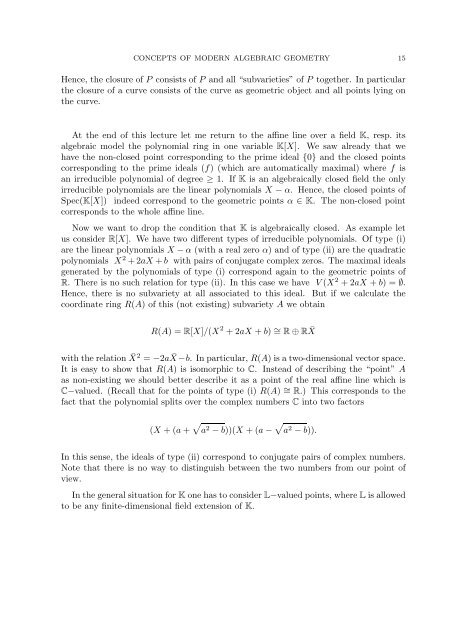Mannheimer Manuskripte 177 gk-mp-9403/3 SOME CONCEPTS OF ...
Mannheimer Manuskripte 177 gk-mp-9403/3 SOME CONCEPTS OF ...
Mannheimer Manuskripte 177 gk-mp-9403/3 SOME CONCEPTS OF ...
- No tags were found...
You also want an ePaper? Increase the reach of your titles
YUMPU automatically turns print PDFs into web optimized ePapers that Google loves.
<strong>CONCEPTS</strong> <strong>OF</strong> MODERN ALGEBRAIC GEOMETRY 15Hence, the closure of P consists of P and all “subvarieties” of P together. In particularthe closure of a curve consists of the curve as geometric object and all points lying onthe curve.At the end of this lecture let me return to the affine line over a field K, resp. itsalgebraic model the polynomial ring in one variable K[X]. We saw already that wehave the non-closed point corresponding to the prime ideal {0} and the closed pointscorresponding to the prime ideals (f) (which are automatically maximal) where f isan irreducible polynomial of degree ≥ 1. If K is an algebraically closed field the onlyirreducible polynomials are the linear polynomials X − α. Hence, the closed points ofSpec(K[X]) indeed correspond to the geometric points α ∈ K. The non-closed pointcorresponds to the whole affine line.Now we want to drop the condition that K is algebraically closed. As exa<strong>mp</strong>le letus consider R[X]. We have two different types of irreducible polynomials. Of type (i)are the linear polynomials X − α (with a real zero α) and of type (ii) are the quadraticpolynomials X 2 +2aX +b with pairs of conjugate co<strong>mp</strong>lex zeros. The maximal idealsgenerated by the polynomials of type (i) correspond again to the geometric points ofR. There is no such relation for type (ii). In this case we have V (X 2 + 2aX + b) = ∅.Hence, there is no subvariety at all associated to this ideal. But if we calculate thecoordinate ring R(A) of this (not existing) subvariety A we obtainR(A) = R[X]/(X 2 + 2aX + b) ∼ = R ⊕ R ¯Xwith the relation ¯X 2 = −2a ¯X −b. In particular, R(A) is a two-dimensional vector space.It is easy to show that R(A) is isomorphic to C. Instead of describing the “point” Aas non-existing we should better describe it as a point of the real affine line which isC−valued. (Recall that for the points of type (i) R(A) ∼ = R.) This corresponds to thefact that the polynomial splits over the co<strong>mp</strong>lex numbers C into two factors(X + (a + √ a 2 − b))(X + (a − √ a 2 − b)).In this sense, the ideals of type (ii) correspond to conjugate pairs of co<strong>mp</strong>lex numbers.Note that there is no way to distinguish between the two numbers from our point ofview.In the general situation for K one has to consider L−valued points, where L is allowedto be any finite-dimensional field extension of K.
















